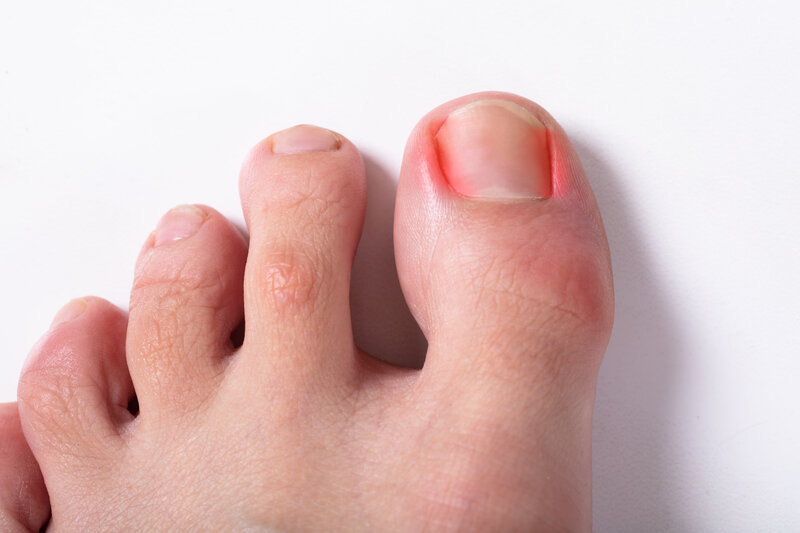Ingrown toenails are a painful and highly common condition that happens when one of your toenails begins to cut into the skin that surrounds your nail rather than growing straight and flat. The larger toes on your feet are the most susceptible to this painful condition, but any toe is at risk of developing an ingrown nail. In this article, we’ll discuss what causes ingrown toenails, how they’re diagnosed, the dangers of ingrown toenails, and what ingrown toenail treatments are available for you today. What Causes Ingrown Toenails?
What Causes Ingrown Toenails?
An ingrown toenail occurs when either one of the sides or a corner of one of your toenails starts to grow into the soft flesh of that toe. Some of the main symptoms of an ingrown toenail are inflamed skin, tenderness, noticeable pain, swelling in the area, and in some cases, infection. Ingrown toenails most often affect the big toe. By noticing and caring for your ingrown toenail early on, you can easily avoid a worse condition. If the pain begins to spread or become more severe, a specialist can take the proper steps to address and relieve your discomfort. Thus, you can avoid severe pain and other possible medical complications.
If you have diabetes or another condition that can cause poor blood flow to your legs and feet, you’re at a greater risk for some of the complications of ingrown toenails. You should also reach out to a healthcare provider if you have:
- a foot infection or sore
- severe discomfort
- inflamed skin
- pus in or around one of your toes
Many things can cause an ingrown toenail, such as cutting your toenails too short, not cutting your toenails straight across, having very curved toenails, injuring a toenail, having a nail infection, or wearing shoes that crowd your toenails. There are also some risk factors to consider with an ingrown nail.
 Mild Ingrown Toenail
Mild Ingrown Toenail
A mild ingrown toenail is essentially an ingrown toenail in the early stages of its development. Taking note of and treating an ingrown toenail in its early stages is the best way to prevent more severe pain or a worse medical condition. A mild ingrown toenail can feel somewhat swollen or hard to the touch. However, if the toenail begins to grow further into the skin or the skin starts to grow further over the edge of the affected nail, bacteria can more easily enter the affected area, putting you at risk of infection. Some of the top signs that your mild ingrown toenail is worsening and possibly becoming infected include pus or liquid discharge, darkening, redness, or warmth.
Ingrown Toenail Diagnosis
You can usually diagnose an ingrown toenail on your own based on how the affected toe looks, and your symptoms. A healthcare provider will usually begin a diagnosis of your condition by first inspecting the affected area. They will likely examine the skin that’s at the edges of the nail. You may be diagnosed with an ingrown toenail if the surrounding toe skin is tender, swollen, red, warm, or growing over the nail. For diagnosis, you usually don’t need any X-rays or other tests. In rare cases, if the toenail becomes severely infected, your specialist may take a sample to better identify the infection.
Risk Factors of an Ingrown Toenail
An ingrown toenail is unlikely to ever become seriously debilitating or fatal. But, it can result in some serious complications if left untreated. You may have underlying medical conditions that could potentially cause considerable complications. A more severe condition combined with one or more underlying medical conditions can result in more serious, potentially dangerous complications. One of the biggest concerns when it comes to an ingrown toenail is the risk of infection. An infection left untreated can spread to some of the underlying bones. Another major concern is the risk of gangrene, when tissue decays away.
Gangrene can leave an open sore on the body, another major concern associated with ingrown toenails left untreated. Infection and gangrene are of specific concern to people with diabetes. Though it can also be a concern with other conditions affecting blood flow to the body’s lower extremities. In some cases such as these, a person may even face the possibility of necessary amputation. Older people with often thicker nails and teens with sweaty feet are at a higher risk of ingrown toenails and their complications. It’s vitally important to be aware of the signs, and symptoms, and seek early medical attention. Other possible complications include a bone infection or a foot ulcer.
Ingrown Toenail Treatment
Treatments for an ingrown toenail include those with chemical intervention or without a form of chemical intervention. Without early and proper treatment of your ingrown toenail with the help of a specialist, you run the risk of further damaging the affected toenail and the surrounding tissue. You can effectively turn your minor problem into a much more painful, infected medical condition. Some conservative home treatment options include soaking your feet, putting floss or cotton under the affected toenail, and wearing properly-fitting shoes.
If more conservative treatments fail to provide lasting relief, your specialist may recommend nail removal. The goal is to remove the portion of the toenail protruding into the toe skin and causing pain. Hopefully, the nail will proceed to grow to its natural proportions instead of inward. If the nail begins to grow inward into the same area again, chemical intervention, such as with chemical phenol may be necessary for lasting relief. Chemical phenol can help prevent toenail growth in the area it’s applied.
 Preventing the Dangers of Ingrown Toenails
Preventing the Dangers of Ingrown Toenails
By knowing the early signs of an ingrown toenail, you can prevent a worse condition. For help diagnosing and treating your toenail today, connect with the Foot & Ankle Specialists of Illinois.

